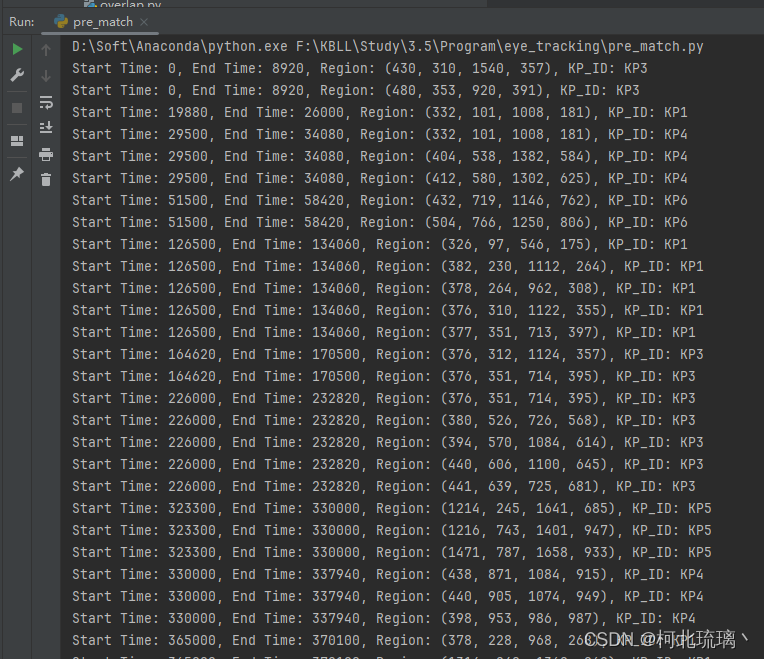接下来,把实时注视点位置、语音文本知识点、帧知识点区域进行匹配;
首先,第一步是匹配语音文本知识点和帧知识点区域,我们知道教师所说的每句话对应的知识点,然后寻找当前时间段内,知识点对应的ppt中的区域,即得到学生应该看的知识点区域,后续我的队友进行可视化展示(视频生成和报告生成);
第二步,检测注视点位置是否在该区域;统计成功匹配的比例即可衡量该学生上课专注程度;

# -*- coding: utf-8 -*-
"""
@Time : 2024/6/22 14:45
@Auth : Zhao Yishuo
@File :pre_match.py
@IDE :PyCharm
"""
import cv2
import re
import io
from matplotlib import pyplot as plt
# Parse voice match final data
def parse_voice_match_final(file_path):
knowledge_points = []
with open(file_path, 'r', encoding='utf-8') as file:
for line in file:
match = re.search(r'range: (\d+)-(\d+); kp_id: (\w+)', line)
if match:
start_time = int(match.group(1))
end_time = int(match.group(2))
kp_id = match.group(3)
knowledge_points.append((start_time, end_time, kp_id))
return knowledge_points
import cv2
import pandas as pd
import re
# 解析 final_match_test.txt
def parse_final_match_test(file_path):
ocr_data = []
with open(file_path, 'r', encoding='utf-8') as file:
timestamp = None
for line in file:
if 'Timestamp' in line:
timestamp = int(line.split(': ')[1])
elif 'Knowledge_point_id:' in line:
match = re.search(r'\((\d+), (\d+), (\d+), (\d+)\): Knowledge_point_id: (\w+)', line)
if match:
x1, y1, x2, y2 = map(int, match.groups()[:4])
kp_id = match.group(5)
ocr_data.append((timestamp, (x1, y1, x2, y2), kp_id))
return ocr_data
# Match knowledge points with OCR/detection regions based on timestamps
def match_knowledge_points(voice_data, ocr_data):
matches = []
for (start_time, end_time, kp_id) in voice_data:
for (timestamp, region, ocr_kp_id) in ocr_data:
if kp_id == ocr_kp_id and start_time <= timestamp <= end_time:
matches.append((start_time, end_time, region, kp_id))
return matches
# Mark regions on the video
def mark_video(input_video_path, output_video_path, matches):
cap = cv2.VideoCapture(input_video_path)
fps = cap.get(cv2.CAP_PROP_FPS)
frame_width = int(cap.get(cv2.CAP_PROP_FRAME_WIDTH))
frame_height = int(cap.get(cv2.CAP_PROP_FRAME_HEIGHT))
total_frames = int(cap.get(cv2.CAP_PROP_FRAME_COUNT))
fourcc = cv2.VideoWriter_fourcc(*'mp4v')
out = cv2.VideoWriter(output_video_path, fourcc, fps, (frame_width, frame_height))
frame_count = 0
current_region = None
current_kp_id = None
region_end_time = None
while cap.isOpened():
ret, frame = cap.read()
if not ret:
break
timestamp = int(frame_count / fps * 1000) # Convert frame count to milliseconds
for match in matches:
start_time, end_time, region, kp_id = match
if start_time <= timestamp <= end_time:
current_region = region
current_kp_id = kp_id
region_end_time = end_time
break
if current_region:
cv2.rectangle(frame, (current_region[0], current_region[1]), (current_region[2], current_region[3]), (0, 255, 0), 2)
cv2.putText(frame, current_kp_id, (current_region[0], current_region[1] - 10), cv2.FONT_HERSHEY_SIMPLEX, 0.5, (0, 255, 0), 2)
out.write(frame)
frame_count += 1
cap.release()
out.release()
if __name__ == "__main__":
# Paths to the files
voice_match_final_path = 'voice_match_final.txt'
final_match_test_path = 'final_match_test(1).txt'
input_video_path = 'video_data/5.mp4' # Path to the input video
output_video_path = 'video_data/5_match.mp4' # Path to save the output video with annotations
# Parse the files
voice_data = parse_voice_match_final(voice_match_final_path)
ocr_data = parse_final_match_test(final_match_test_path)
# Match the knowledge points with OCR/detection regions
matches = match_knowledge_points(voice_data, ocr_data)
# Print matches for debugging
for match in matches:
print(f"Start Time: {match[0]}, End Time: {match[1]}, Region: {match[2]}, KP_ID: {match[3]}")
# Mark the video with matched regions
# mark_video(input_video_path, output_video_path, matches)

# -*- coding: utf-8 -*-
"""
@Time : 2024/6/16 14:52
@Auth : Zhao Yishuo
@File :match.py
@IDE :PyCharm
"""
import cv2
import pandas as pd
import os
import pandas as pd
import matplotlib.pyplot as plt
import seaborn as sns
import numpy as np
from sklearn.preprocessing import StandardScaler,MinMaxScaler
plt.rcParams['font.sans-serif'] = ['SimHei']
# 手动读取和处理眼动数据文本文件
eyedata_path = 'eye_output_16.txt' # 文本文件路径
data = []
with open(eyedata_path, 'r') as file:
for line in file:
line = line.strip()
if ':' in line: # 检查是否存在冒号
key, value = line.split(':', 1)
data.append([key.strip(), value.strip()])
# else:
# print(f"Skipping malformed line: {line}") # 记录格式不正确的行
data = pd.DataFrame(data, columns=['Type', 'Value'])
# 清洗数据
timestamps = data['Value'][data['Type'] == 'Timestamp'].astype(float).reset_index(drop=True)
videos = data['Value'][data['Type'] == 'Video'].reset_index(drop=True)
positions = data['Value'][data['Type'] == 'Relative Position'].str.extract(r'\[(.*?)\]')[0] # 眼动位置
positions = positions.str.split(expand=True).astype(float).reset_index(drop=True)
positions[0] = round(positions[0])
positions[1] = round(-positions[1])
# 提取第1列和第2列
data = positions.iloc[:, [0, 1]]
# 确保数据为数值类型
data = data.apply(pd.to_numeric, errors='coerce')
# print(type(data))
x_values = data[0].tolist()
y_values = data[1].tolist()
eye_pos = np.vstack([x_values, y_values]).T # df类型成功转换为np数组
eye_timestamps = np.array(timestamps.tolist())
# np.save('eye_positions.npy', eye_pos)
# np.save('eye_timestamps.npy', eye_timestamps)
eye_pos = np.load('eye_positions.npy')
eye_timestamps = np.load('eye_timestamps.npy')
# print(eye_pos,eye_timestamps)
text_path = 'final_match_test.txt'
import re
# Function to parse the text file and extract data
def parse_text_file(file_path):
with open(file_path, 'r', encoding='utf-8') as file:
content = file.read()
# Regular expressions to match timestamps, OCR, and detection positions
timestamp_pattern = re.compile(r'Timestamp: (\d+)')
ocr_pattern = re.compile(r'OCR \d+: \((\d+), (\d+), (\d+), (\d+)\) \(Knowledge_point_id: KP\d+\) (.+)')
detection_pattern = re.compile(r'Detection \d+ \(Knowledge_pdoint_id: (KP\d+(?:, KP\d+)*)\): \((\d+), (\d+), (\d+), (\d+)\)')
# Lists to store parsed data
parsed_data = []
# Current timestamp
current_timestamp = None
# Split content by lines
lines = content.split('\n')
for line in lines:
# Check for a timestamp
timestamp_match = timestamp_pattern.match(line)
if timestamp_match:
current_timestamp = int(timestamp_match.group(1))
# Check for OCR match
ocr_match = ocr_pattern.match(line)
if ocr_match:
x1, y1, x2, y2, ocr_text = ocr_match.groups()
parsed_data.append((current_timestamp, ocr_text, (int(x1), int(y1), int(x2), int(y2))))
# Check for detection match
detection_match = detection_pattern.match(line)
if detection_match:
knowledge_points, x1, y1, x2, y2 = detection_match.groups()
parsed_data.append((current_timestamp, f'Detection with {knowledge_points}', (int(x1), int(y1), int(x2), int(y2))))
return parsed_data
# Parse the file and print the extracted data
parsed_data = parse_text_file(text_path)
text_timestamps = []
text_pos = []
for entry in parsed_data:
# print(entry)
text_timestamps.append(np.float32(entry[0])/1000)
text_pos.append(np.array(entry[-1],dtype=np.float32))
text_timestamps = np.array(text_timestamps)
text_pos = np.array(text_pos)
def check_gaze_in_regions(gaze_timestamps, gaze_positions, parsed_data):
results = []
gaze_idx = 0
num_gaze_points = len(gaze_timestamps)
idx = 0
while idx < len(parsed_data):
temp_gaze = []
temp_text = []
# print('timestamp,rect_coords',timestamp,rect_coords)
# Find gaze points that fall within the current timestamp range
while (gaze_idx < num_gaze_points and gaze_timestamps[gaze_idx] >= text_timestamps[idx]):
print(gaze_idx,num_gaze_points,gaze_timestamps[gaze_idx],text_timestamps[idx + 1])
temp_gaze.append(gaze_idx)
temp_text.append(idx)
gaze_idx += 1
idx += 1
while gaze_timestamps[gaze_idx] >= text_timestamps[idx - 1] and gaze_timestamps[gaze_idx] <= text_timestamps[idx]:
gaze_idx += 1
gaze_idx -= 1
# print(temp_text)
print('gaze_idx,idx',gaze_idx,idx)
if gaze_idx >= num_gaze_points:
break
# Check if gaze point is within rectangle region
if gaze_idx < num_gaze_points and gaze_timestamps[gaze_idx] <= text_timestamps[idx + 1]:
# print(1)
for temp_gaze_idx in temp_gaze:
gaze_x, gaze_y = gaze_positions[temp_gaze_idx]
# print('gaze_x,gaze_y',gaze_x,gaze_y)
for temp_text_idx in temp_text:
# print('text_pos[temp_text_idx]',text_pos[temp_text_idx])
x1, y1, x2, y2 = text_pos[temp_text_idx]
print('gaze_x,gaze_y,x1,y1,x2,y2',gaze_x,gaze_y,x1,y1,x2,y2)
if x1 <= gaze_x <= x2 and y1 <= gaze_y <= y2:
print('match found')
results.append(timestamp, gaze_positions[temp_gaze_idx])
break
return results
results = check_gaze_in_regions(eye_timestamps, eye_pos, parsed_data)
# Print or process results
for result in results:
print(result)